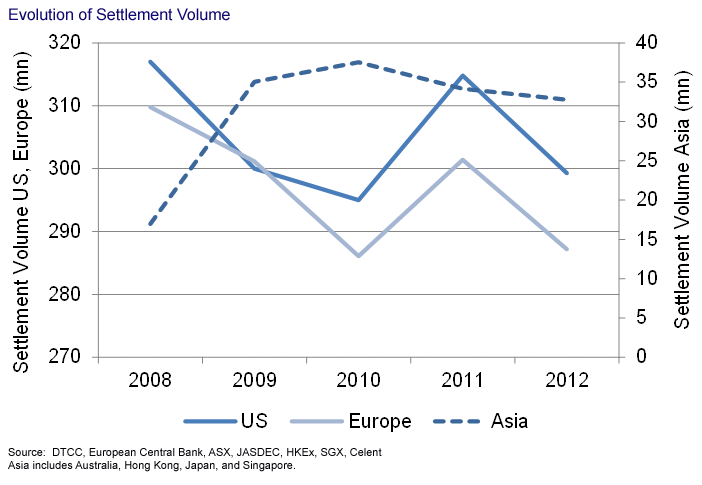Future of the Post-Trade Industry, Part II: Rising Market Concentration
Abstract
The future of the post-trade industry will depend on the evolution of numerous drivers. Key among them will be the macroeconomic situation in the US and Europe.
In the report Future of the Post-Trade Industry, Part II: Rising Market Concentration, Celent assesses the impact of several drivers on the post-trade industry and estimates their contribution to the growth in settlement volume over the next five year period, as well as their impact on the concentration of market participants. The post-trade industry faces the downstream consequences of trading activities. Due to uncertainty in the economic and trading environment, the evolution of settlement volume in US and Europe has been volatile since 2008; settlement volume has fallen since then and was down by 5% in US and 7% in Europe in 2012 compared to their levels in 2008. The four advanced countries in Asia, on the other hand, have exhibited an opposite trend.

The macroeconomic situation in the US and Europe will be a key factor in determining the evolution of settlement volume; however, there are many other drivers that will reshape the industry. The impact could be most dramatic in Europe. The persisting Eurozone crisis will add to the uncertainty in the trading environment. The slow but steady recovery that has started in the US should boost settlement volumes among all participants in the US. Favorable economic climate in the Western markets will add to the long-term trends of capital market development in Asia to take volumes higher.
“The post-trade industry will see growing concentration among its participants, and post-trade processing will increasingly become a scale business,” says Arin Ray, Analyst with Celent’s Securities & Investments Group and coauthor of the report. “This trend will be seen particularly in Europe, especially among market infrastructure and custody service providers.”
“The myriad of drivers of settlement volume that we have analyzed make us foresee significant consolidation along the entire trading value chain, from exchanges to local subcustodians, with broker-dealers also being impacted,” says Joséphine de Chazournes, Senior Analyst with Celent’s Securities & Investments Group and coauthor of the report. “These developments will mean smaller players will need to consider strategies for survival, while larger players will need to explore opportunities to gain market share in businesses that are increasingly based on scale.”
This report builds on a previous Celent report that identified the drivers that will be reshaping the post-trade industry. In this report we first analyze the impact of those drivers on different geographies, then analyze their impact on the concentration of market participants including market infrastructure providers, custody service providers, investment managers, and broker-dealers. We analyze the drivers’ impact on settlement volume by considering three future scenarios — bull, base, and bear — to assess how industry volume will evolve. Finally, we provide Celent’s recommendations about what firms in the post-trade ecosystem need to do to stay competitive in the evolving environment.

